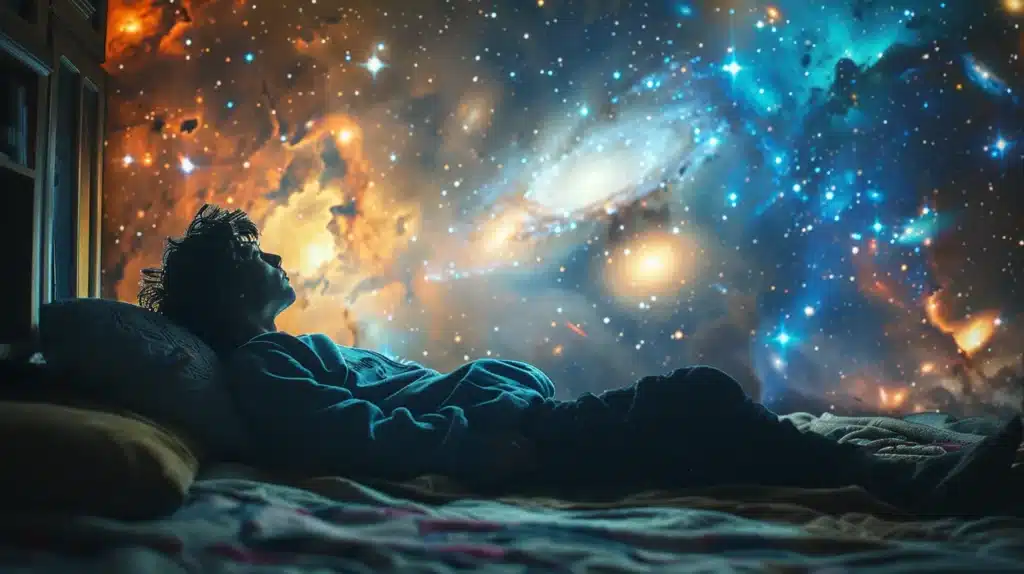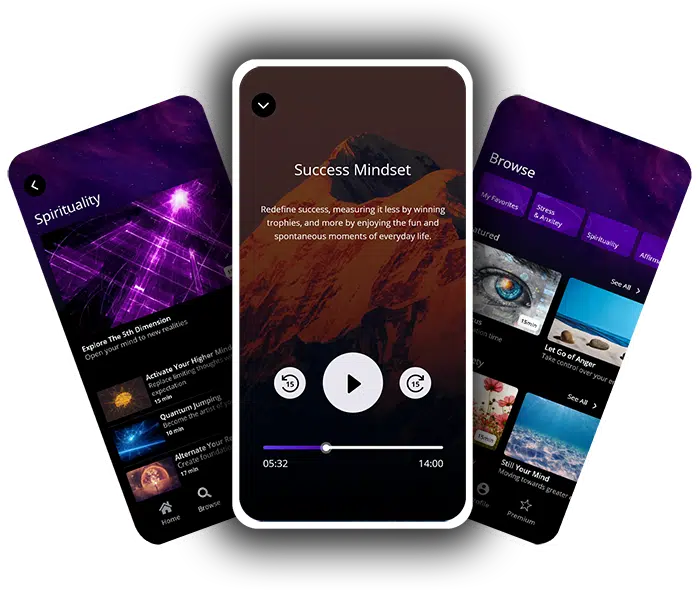Shifting is real! Have you ever felt like jumping into a whole new world, just like in the movies? Reality shifting claims to let people do just that. This blog post will guide you through what reality shifting is, how it works, and whether it’s all in your head or something more.
Keep reading to find out!

Unleash Your True Potential!
Explore the world of meditation with our powerful guided sessions crafted to bring peace and strength to your spirit.
But first, let’s ensure our sessions are the perfect fit for you.
Take our short quiz to find out!
Table of contents
Key Takeaways
- Reality shifting lets people enter an alternate reality through focus and techniques like self-hypnosis and lucid dreaming. They use methods such as the Raven Method or visualization to dive into worlds from books and movies, feeling like they’re truly there.
- People drawn to reality shifting often have a strong imagination and can easily get lost in their thoughts. This ability allows them to experience vivid, detailed fantasies that feel real, including emotions and physical sensations.
- TikTok has helped spread the word about reality shifting, with 1.8 billion views on related content. Many seek it out for fun or as an escape from daily life, exploring places like Hogwarts from Harry Potter.
- Similar experiences include lucid dreaming where you control your dreams, hypnosis for heightened focus, and immersive daydreaming which involves deep daydreams that can seem real but might affect mental health if overdone.
- It’s debated whether reality shifting is just a form of intense daydreaming or something more profound. Some believe it offers personal growth and creativity boosts while others warn against losing touch with actual reality.
Understanding Reality Shifting

Reality shifting involves entering an alternate reality through absorption, dissociation, and fantasy-proneness. The process includes induction methods, exploring popular desired realities, and understanding the motivation behind it.
Absorption
Absorption in reality shifting means getting really into another world inside your mind. You focus so hard that the world around you fades away. This happens a lot during self-hypnosis and lucid dreaming, two key parts of shifting realities.
People can get so absorbed; they feel like they’re living in a completely different universe, like Hogwarts or other places from books and movies.
Shifting isn’t just daydreaming; it’s an intense concentration where your current reality slips away.
TikTok users talk about this using scripts and affirmations to help narrow their attention on their desired reality. They use methods like counting or visual cues to dive deep into these experiences, ignoring anything else around them.
This skill lets them explore fictional worlds as if they were actually there, giving a sense of control over where they go and what they do in those alternate realities.
Dissociation
Dissociation lets a person feel detached from their present world. It’s like stepping into a different reality while still being aware of the old one. This process helps shifter focus on the desired reality they want to explore, such as Hogwarts or any other universe they dream up.
By using techniques like visualization and affirmations, shifters can experience a vivid and life-like alternate existence beyond their current lives.
During dissociation, attention shifts away from everyday distractions. The mind enters a state where it becomes easier to visit alternate realities without physical travel. Tools like “counting to 100” or sitting against a tree help in this alteration of consciousness.
These methods narrow down focus and allow for a deeper immersion into another world, making the shifting experience more intense and real for those who try it.
Fantasy-Proneness
Some people find it easy to get lost in their imaginations. This is called fantasy-proneness. People who are highly prone to fantasy can often create vivid, detailed worlds in their minds.
They might spend a lot of time daydreaming and have a rich inner life.
Studies show that these individuals can even feel real emotions and physical sensations from their imagined experiences. For example, they may be more likely to report intense near-death experiences or believe they’ve visited other realities.
Their ability to focus deeply on their fantasies helps them shift into alternate states of consciousness without much effort.
The Shifting Process

Embark on the shifting journey through induction methods and the phenomenology of the process. Discover popular desired realities and explore the motivation behind it.

Unleash Your True Potential!
Explore the world of meditation with our powerful guided sessions crafted to bring peace and strength to your spirit.
But first, let’s ensure our sessions are the perfect fit for you.
Take our short quiz to find out!
Induction Methods
- To initiate reality shifting, individuals typically use a relaxation technique to attain a focused state of mind. This then allows them to direct their attention towards their desired alternate reality. They often utilize specific methods such as the Raven Method or visualization exercises.
- Some individuals use the “Raven Method” to stimulate their subconscious mind and achieve a relaxed state before attempting to shift their reality. They might also use subliminals or affirmations as part of their process.
- Visualization exercises are commonly employed in induction methods for reality shifting, where individuals create detailed scripts or imagine themselves transitioning into their desired alternate reality using vivid imagery.
- The concentration of attention is vital during induction methods, with techniques such as counting to 100 or focusing on a specific object aiding in achieving the necessary state for reality shifting.
- Elevator-based techniques involve visualizing oneself entering an elevator, ascending past various floors, and finally arriving at the desired alternate reality when the doors open.
- Other common methods include falling down a “rabbit hole” or using sensory stimuli like music or scents to help facilitate the transition into the desired alternate reality.
- A combination of relaxation and focus-inducing activities are often employed by individuals seeking to shift realities, including deep breathing exercises, meditation, and purposeful narrowing of attention while ignoring external distractions.
Related: 10 Effective Awake Shifting Methods For A New Reality
Phenomenology
Phenomenology is the study of conscious experiences during reality shifting. It focuses on how individuals perceive and interpret their desired realities or alternate dimensions. This involves understanding the feelings, sensations, and thoughts people have while attempting to shift into a different reality.
During the process of reality shifting, phenomenology explores the vivid and life-like alternate realities experienced by individuals. It delves into the mental states and perceptions encountered when entering these imagined worlds.
The field also considers how absorption, dissociation, and fantasy-proneness contribute to these immersive experiences during reality shifting activities like visualization exercises or self-hypnosis techniques used in attempting to transcend present physical confines.
Popular Desired Realities
Online communities surrounding reality shifting often discuss popular desired realities that individuals aim to shift into. These desired realms are diverse, ranging from fantasy worlds inspired by literature and films like Harry Potter, to original environments designed by the individual.
Proponents of reality shifting emphasize the importance of motivation in shaping these alternate realities, with users sharing vivid and detailed descriptions of their ideal shifts across platforms like TikTok.
The growing interest in these sought-after experiences reflects a significant belief in the practice of reality shifting as more than just daydreaming or mental exercise, but rather a conscious and genuine immersion into alternate realms.
Motivation
Many individuals seek reality shifting as a way to temporarily escape from daily challenges and immerse themselves in alternate realities. The phenomenon’s growing popularity, particularly within online communities like TikTok, suggests an increasing interest in this practice that may share psychological similarities with hypnosis and dissociation.
With 1.8 billion views on TikTok alone related to reality shifting content, the motivation behind seeking different realms appears to resonate with a significant number of people.
Exploring the Realities of Shifting

Reification involves individuals vividly experiencing alternative realities, blurring the line between fantasy and reality. Respawning is an extreme form of reality shifting where individuals seek to permanently escape their current reality. Additionally, reality shifting allows for immersion into fictional Harry Potter environments, enhancing the appeal of this practice. Each aspect fuels ongoing discussions about the nature and impact of reality shifting.
Reification
Shifting creates a strong sense of presence in desired realities, leading to the concrete reality of these experiences, known as reification. Some practitioners believe their shifted realities are real and report experiencing a vivid sense of presence in those realities, contributing to the actuality of their experiences.
The debate on whether reality shifting is a psychological daydream or an alteration of reality sparks discussions about reification. Individuals may feel deeply present in their desired realities, which contributes to the validation and concreteness of their experiences.
Respawning
Respawning is a drastic form of reality shifting, where individuals disconnect from their current reality. It’s distinct from permashifting and involves severing ties to the present reality.
Some practitioners aim to permanently break free from their current existence.
Harry Potter Environments
Reality shifting includes the intriguing possibility of visiting environments inspired by the Harry Potter series. This phenomenon enables individuals to immerse themselves in fictional realms such as Hogwarts, providing a unique and vivid experience.
The association between reality shifting and Harry Potter environments has captured the attention of many individuals exploring this extraordinary practice.
Similar Phenomena
Other phenomena related to reality shifting include lucid dreaming, hypnosis, immersive daydreaming, and tulpamancy. These experiences share similarities with reality shifting and offer further insights into altered states of consciousness.
Tulpamancy
Tulpamancy, linked to reality shifting, is a fascinating psychological concept. It’s an emergent online daydreaming culture with unique perspectives. The proposed theoretical model of reality shifting compares it to tulpamancy, hypnosis, and dissociation.
These connections shed light on the deeper intricacies of conscious perception and mental states. Tulpamancy brings a fresh understanding to the ever-changing realm of human cognition and inner experiences.
Lucid Dreaming
Lucid dreaming is a real psychological phenomenon based on scientific evidence. It allows individuals to be aware and in control of their dreams, offering therapeutic potential for conditions such as recurring nightmares and PTSD.
Unlike myths surrounding magic and reality shifting, lucid dreaming has a strong foundation in scientific research and offers practical benefits.
Some people have found relief from persistent nightmares through the use of lucid dreaming techniques in therapy. This demonstrates its credibility as a legitimate tool in mental health treatment.
Hypnosis
Hypnosis involves heightened focus and reduced peripheral awareness. It’s associated with a singular, immersive experience akin to reality shifting. Certain reality shifting techniques may incorporate elements of self-hypnosis, leveraging similar states of consciousness for achieving desired realities.
As a reader curious about reality shifting, it’s crucial to recognize the parallels between hypnosis and alternate reality experiences. The utilization of self-hypnosis in reality shifting methods underlines the potential psychological connections between these phenomena.
Immersive and Maladaptive Daydreaming
Immersive and maladaptive daydreaming involves deeply absorbing, altered perceptions of reality. These experiences are characterized by vivid and highly immersive fantasies that can seem real.
Common themes in maladaptive daydreaming may include violence, power, control, or rescue, reflecting a deep escapism from the current reality into an alternate world of one’s creation.
The Psychological Perspective on Reality Shifting
The psychological perspective on reality shifting examines individual differences and the relation to associated phenomena. It delves into the complexities of the mind when it comes to experiencing and navigating different realities.
Individual Differences
Individual differences in personality traits and cognitive abilities play a significant role in reality shifting. These differences can influence one’s level of absorption, susceptibility to suggestion, and creativity, shaping the way individuals engage in immersive daydreaming experiences.
Moreover, specific psychological dispositions or interests may attract individuals to the practice of reality shifting, leading to variations in experiences and beliefs about its potential reality.
As a result, proponents of reality shifting exhibit varying motivations and expectations for engaging in the practice, reflecting individual differences in desires for self-exploration and personal growth.
Relations with Associated Phenomena
Reality shifting has a close relationship with related psychological phenomena like hypnosis, tulpamancy, and dissociation. These concepts are interconnected and share similarities in how they relate to altered states of consciousness and the exploration of alternate realities.
The practice of reality shifting involves techniques akin to self-hypnosis and lucid dreaming, which are also core elements of related phenomena such as immersive daydreaming and dissociation.
This interconnection highlights the shared aspects among these psychological processes in relation to altering one’s perception of reality and experiencing alternate states of being.
The phenomenon of reality shifting is often compared with other psychological practices such as lucid dreaming, tulpamancy, hypnosis, and dissociation due to their shared characteristics in exploring altered states of consciousness.
These connections emphasize the interrelated nature between reality shifting and other mental processes that involve manipulating or transcending one’s typical experience of reality.
Is Shifting Real?
Is reality shifting a genuine phenomenon or just psychological daydreaming? What does the evidence and research suggest?
Benefits and Risks
Reality shifting can have both positive and negative effects on mental health. It is crucial to understand the potential impacts before attempting to shift realities:
- Enhanced creativity and imagination: Shifting allows for the exploration of new, imaginative worlds and experiences, which can stimulate creativity and expand imaginative capabilities.
- Potential risks to mental well-being: Overindulgence in reality shifting can lead to detachment from actual reality, causing confusion between real-life experiences and shifted realities.
- Personal growth and self-discovery: Some individuals report that reality shifting has helped them explore different aspects of themselves and gain new perspectives on life.
- Impact on mental health: Excessive engagement in reality shifting without a balanced approach can lead to anxiety, dissociation, or confusion about one’s own identity.
- Emotional regulation: Shifting may offer a temporary escape from real-world stressors, but excessive reliance on shifting as a coping mechanism may hinder the development of healthy emotional regulation skills.
- Spiritual exploration: For some individuals, reality shifting serves as a means of spiritual exploration and self-discovery, providing a sense of connection to something greater than themselves.
Summary and Recommendations for Future Research
Future research should delve into the psychological characteristics of individuals who engage in reality shifting, examining how absorption, dissociation, and fantasy-proneness contribute to this phenomenon.
Additionally, developing a deeper understanding of the potential benefits and risks associated with reality shifting is crucial for providing guidance and support to those participating in this activity.
Furthermore, exploring the similarities and differences between reality shifting and related phenomena such as lucid dreaming, tulpamancy, hypnosis, and immersive daydreaming can shed light on the underlying mechanisms at play.
It is also essential to investigate the impact of external factors such as social media trends or cultural influences on the prevalence of reality shifting. Understanding the demographics and motivations of individuals interested in reality shifting will provide valuable insights for tailored interventions designed to support those engaging in this experience.
Conclusion
Reality shifting is a perplexing and compelling phenomenon that has captured the interest of many. The exploration of desired realities through methods like self-hypnosis and lucid dreaming has created an intriguing realm within online communities.
While questions about its psychological implications persist, the trend of reality shifting continues to provoke curiosity and discussion. This enigmatic practice invites ongoing research into its features and effects, challenging our understanding of consciousness and perception.
FAQs
1. What is reality shifting?
Reality shifting is when people believe they can move their consciousness to a different reality, often called a “desired reality,” and it’s based on the idea of the multiverse.
2. How do people try to shift realities?
People use various methods like the “Alice in Wonderland” method, where they visualize themselves falling down a rabbit hole into another world, or they might count to 100 and use affirmations to help shift.
3. Is shifting real or just imagination?
Some say shifting is very real, claiming they’ve experienced vivid alternate realities. Others believe it’s more like an intense daydream or psychological state.
4. Can anyone learn how to shift?
Yes, many who practice shifting say that with focus and practice, such as narrowing attention and ignoring distractions, anyone can attempt to experience a different reality.
5. Did the pandemic affect interest in reality shifting?
Yes, during the COVID-19 pandemic in 2020, interest in reality shifting grew among TikTok users as people looked for an escape from their current situations.
6. Is there any danger in trying to shift realities?
While most experiences are safe, it’s important to have a “safe word” or way back to your original reality if needed; focusing too much on another world could distract from real-life responsibilities.










